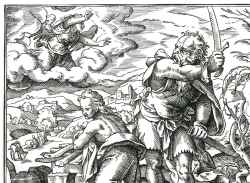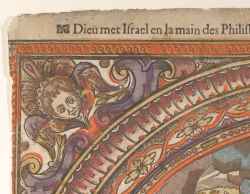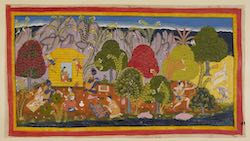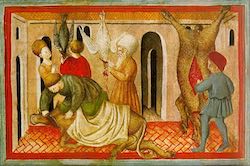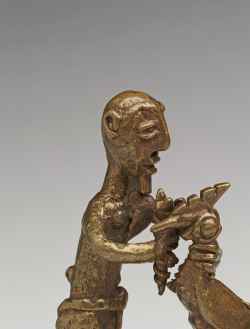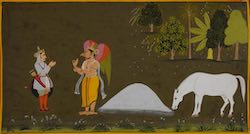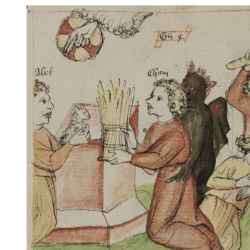Keyword: Animal Sacrifice
Persons bringing sacrifices to Hercules (1629)
from: Philostratus of Lemnos. Les images ou tableaux de platte peinture des deux Philostrates, sophistes grecs, et les Statues de Callistrate, tr. Blaise de Vigenère. Paris. 1629, p. 494.
The Warburg Institute, London
Sous le masque de l'animal : essay sur le sacrifice en Afrique noire
Paris: Presses universitaires de France, 1987.
Sacrifice, Cult, and Atonement in Early Judaism and Christianity: Constituents and Critique
Atlanta: Society of Biblical Literature, 2017.
The Women Sacrificing an Ass to Priapus (1553)
Museum Boymans van Beuningen, Rotterdam
Shepherd sacrificing Ram
from: Book of Meshal Ha-Kadmoni (from Germany)
Munich, Bayerische Staatsbibliothek, Cod. hebr. 107 (Steinschneider 1895, No. 107), fol. 24
A parallel between Indic and Babylonian Sacrificial Ritual
in: Journal of the American Oriental Society, v. 54 (1934), issue 2: pp.107-128.
Capitulo 14: De sus Sacrificios, donde comoy por que causas los hacian
in: “Historia de las islas e indios de Bisayas, parte mayor i más principal de las islas Filipinas: dividida en dos partes, la primera natural, del sitio, fertilidad i calidad de estas islas i sus moradores, etc. La 2ª eclesiástica i sobrenatural, de su fee i aumentos en ella con el magisterio i enseñanza de los P.P. de la Compañía de Jesús (ms)”
: Ms, 1668.
Angel announcing the Birth of Samson, from the Story of Samson (1560–80)
from: France
New York, The Metropolitan Museum of Art
Prior to taking up their abode in the hut, oblations have to be made to the presiding deities. Lakṣmaṇa hunts deer on the right, and returns to the hut to cook it; Rāma offers part of it as a sacrifice. The two brothers then eat, while Sītā waves a scarf over the food to keep the flies off, and she then retires to the hut to eat her own meal. The three begin their lives in exile in the peace of Citrakūṭa (ca 1653)
from: Ramayana, [ms Add. 15296(1), fol. 71]
British Library, London [from Udaipur]
15th c. depiction of Jewish ritual slaughter of animals for consumption (15th)
from: Jacob b. Asher, Arba'ah Turim (Hebrew: אַרְבָּעָה טוּרִים)
Biblioteca Apostolica Vaticana, Cod. Ross. 555. fol. 127v
A King Sacrificing (17th Century)
Royal Collection Trust, London
a man sacrificing a fowl to one of the best known charms among the Akan, the nkabere charm. (18th-20th)
from: Ghana (The Kyekyere Nkabere charm (lit. to tie or bind the nkabere) was a common rite carried out throughout the Asante region during the pre-colonial and early colonial era).
British Museum, London
A mountain city with multistoried hill architecture. Outside the gates on the right is a Saivite shrine with a lingum covered by floral offerings to which a goat is led, probably for sacrifice. (17th)
from: Unidentified Hindu chronicle of a King
Metropolitan Museum, New York
A scene with fakirs and ritualistic animal sacrificeFaquires Bequedes Mahometans (1678-1686)
from: Nicolo Manucci, Histoire de l'Inde depuis Tamerlank jusquà Orangzeb [ms Libro Rosso, fol. 50v]
Bibliothèque nationale de France, Paris
Anshuman finds the horse and the ashes of his sixty thousand uncles. In great distress, he looks for water with which to sprinkle the ashes. His maternal uncle Garuda advises him to return with the horse in order to complete the sacrifice. He also says that the pure water of the river Ganges should be sprinkled on the ashes of his uncles in order for them to attain heaven (1712)
from: Ramayana, Bala Kanda, Ms Add. 15295, fol. 117
British Library, London [from Udaipur]
Cain killing Abel, besides Cain and Abel sacrificing (15th)
from: Speculum humanae salvationis Stiftsbibliothek - Cod. 166, fol. 21r
Neustift bei Brixen (Novacella), Stiftsbibliothek




